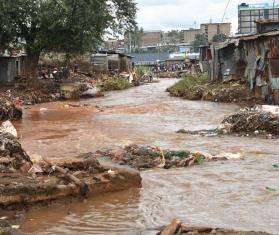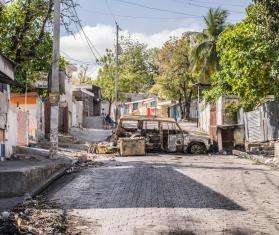MSF and DNDi call on World Health Assembly to pass resolution that includes access to Chagas diagnosis and treatment in primary healthcare
Geneva, May 17, 2010 – A World Health Assembly (WHA) resolution on Chagas disease control and elimination, to be adopted this week, is a step in the right direction but does not go far enough to fully tackle the disease since it focuses only on prevention, the international medial humanitarian organization Doctors Without Borders/Médecins Sans Frontières (MSF) and the Drugs for Neglected Disease initiative (DNDi) said today.
The groups are calling on WHA member states to also focus on the integration of diagnosis and treatment of Chagas at primary health care levels and to increase research and development of effective drugs to treat the parasitic disease, common in parts of Latin America.
“After more than 10 years of experience, MSF has successfully treated thousands of patients with Chagas,” said Fran Román, vice-president of MSF. “We would like to see equal importance given to treatment and diagnosis as to prevention strategies. The countries affected must agree to integrate diagnosis and treatment at the primary health level if they want to reach all patients—children and adults—in both acute and chronic phases of the disease.”
While the intention of the resolution is to control and eliminate Chagas disease, it includes no clear statement addressing diagnosis, treatment once patients are diagnosed, or the research and development of new tools to the fight the disease.
“Chagas patients have been forgotten because they are poor and fall outside mainstream market interest,” said Bernard Pecoul, executive director of DNDi. “But science exists to develop better treatments and diagnostic tools for all. The first steps toward progress at an international level are through sustainable, predictable funding and strong public support. The delegates at the WHA now have the opportunity to move forward and take concrete action,” he said.
The WHA resolution has the potential to impact millions of people infected by Chagas, the leading parasitic killer in the Americas, with an estimated 10 to 15 million people infected per year.
The WHA should follow the example of the Pan American Health Organization (PAHO), which prioritized treatment in its 2009 resolution “Elimination of neglected diseases and other poverty-related infections,” said the organizations.
Urgent actions and measures to increase medical response must be taken to scale up diagnosis, treatment and patient access to care and to boost research and development for new tools. MSF and DNDi also call on member states to reinforce the supply chains of existing treatments so that they are available to health staff and national programs and to promote much-needed research and development, which is virtually non-existent. They also urge a focus on better treatment (less toxic, shorter and more efficient treatment courses in all stages of the disease for children and adults), diagnostic tools adapted to the limited resources settings and a test of cure to control Chagas disease.
About American Trypanosomiasis or Chagas Disease
Each year, an estimated 10 to 15 million people across the world are infected with the Chagas disease. Every year 14,000 people die as a consequences of the disease. Endemic in 21 Central and Latin American countries, it also has growing presence in non-endemic countries through migration of people. In Central and South America, Chagas kills more people than any other parasite-borne disease, including malaria. The disease is caused by the parasite Trypanosoma cruzi transmitted primarily by insects known as “kissing bugs”. The existing treatments have an unsatisfactory cure rate and can have toxic side effects. DNDi aims to develop affordable, safe, and efficacious treatments for children and adults.
Doctors Without Borders /Médecins Sans Frontières/ (MSF) has screened more than 60,000 people for Chagas and has treated over 3,000 patients with the disease since 1999. MSF opened its first Chagas treatment program in Honduras. MSF has developed programs in Nicaragua, Guatemala and currently screens, diagnoses and treats children and adults in Bolivia and Colombia. A new project is opening in Paraguay.
About DNDi
The Drugs for Neglected Diseases initiative (DNDi) is a not-for-profit product development partnership working to research and develop new and improved treatments for neglected diseases, in particular human African trypanosomiasis, leishmaniasis, Chagas disease, and malaria. With the objective to address unmet patient needs for these diseases, DNDi was established in 2003 by the Oswaldo Cruz Foundation from Brazil, the Indian Council for Medical Research, the Kenya Medical Research Institute, the Ministry of Health of Malaysia, the Pasteur Institute, and Doctors Without Borders/Médecins Sans Frontières (MSF). WHO/TDR acts as a permanent observer. Working in partnership with industry and academia, DNDi has the largest ever R&D portfolio for kinetoplastid diseases. Since 2007, DNDi has delivered three products, two fixed-dose anti-malarials “ASAQ” and “ASMQ”, and a combination treatment for the advanced stage of sleeping sickness “NECT” (nifurtimox-eflornithine combination therapy).
The first Chagas treatment for children, pediatric strength benznidazole, will be made available in the near future by DNDi and Pharmaceutical Laboratory of Pernambuco (LAFEPE) in Brazil. Furthermore, in 2009 DNDi signed a collaboration and license agreement with the Japanese pharmaceutical company Eisai Co. Ltd. for the clinical development of the promising compound E1224, to treat Chagas disease.



